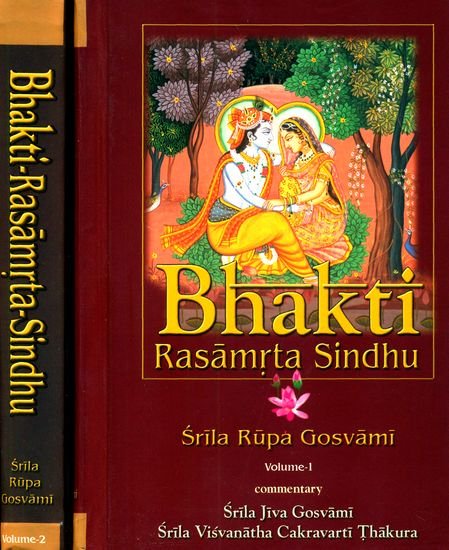Bhakti-rasamrta-sindhu
by Śrīla Rūpa Gosvāmī | 180,912 words
The English translation of the Sri Bhakti-rasamrta-sindhu verse 2.1.161; a medieval era Sanskrit book, written by Rupa Goswami (fl. 15th century) which represents a devotional (bhakti) masterpiece. In this work Goswami describes the nature and different forms of pure love (rasa) as well as various other topics on Vaishnavism and devotion.
Verse 2.1.161
Sanskrit text, Unicode transliteration and English translation:
यथा वा ललित-माधवे (५.१८) —
भीता रुद्रं त्यजति गिरिजा श्यामम् अप्रेक्ष्य कण्ठं
शुभ्रं दृष्ट्वा क्षिपति वसनं विस्मितो नील-वासाः ।
क्षीरं मत्वा श्रपयति यमी-नीरम् आभीरिकोत्का
गीते दामोदर-यशसि ते वीणया नारदेन ॥२.१.१६०॥yathā vā lalita-mādhave (5.18) —
bhītā rudraṃ tyajati girijā śyāmam aprekṣya kaṇṭhaṃ
śubhraṃ dṛṣṭvā kṣipati vasanaṃ vismito nīla-vāsāḥ |
kṣīraṃ matvā śrapayati yamī-nīram ābhīrikotkā
gīte dāmodara-yaśasi te vīṇayā nāradena ||2.1.160||
English translation
Sanskrit text, Unicode transliteration and English translation:
अनोथेर् एxअम्प्ले fरोम् ललित-माधव:
“ओ दामोदर कृष्ण! Wहेन् नारद, प्लयिन्ग् हिस् वीणा, बेगन् तो सिन्ग् योउर् ग्लोरिएस्, पार्वती, नोत् सेएइन्ग् थे ब्लुए चोलोर् ओन् शिव’स् थ्रोअत्, लेfत् हिस् अबोदे; बलराम सेएइन्ग् हिस् ब्लुए च्लोथ् तुर्न् wहिते, गवे इत् उप् इन् अस्तोनिस्ह्मेन्त्; अन्द् थे एxचितेद् चोwहेर्द् wओमेन्, सेएइन्ग् थे ब्लुए wअतेर् ओf थे यमुना तुर्न् wहिते अन्द् थिन्किन्ग् ओf इत् अस् मिल्क्, बेगन् तो छुर्न् इत्.”
(४४) रक्त-लोकः —
पात्रं लोकानुरागाणां रक्त-लोकं विदुर् बुधाः ॥२.१.१६१॥Another example from Lalita-mādhava:
“O Dāmodara Kṛṣṇa! When Nārada, playing his vīṇā, began to sing Your glories, Pārvatī, not seeing the blue color on Śiva’s throat, left his abode; Balarāma seeing His blue cloth turn white, gave it up in astonishment; and the excited cowherd women, seeing the blue water of the Yamunā turn white and thinking of it as milk, began to churn it.”(44) rakta-lokaḥ —
pātraṃ lokānurāgāṇāṃ rakta-lokaṃ vidur budhāḥ ||2.1.161||
English translation
(44) rakta-lokaḥ: attractive to all people —
“The intelligent say that the person who is the object of attraction for all people is called attractive to people.”
